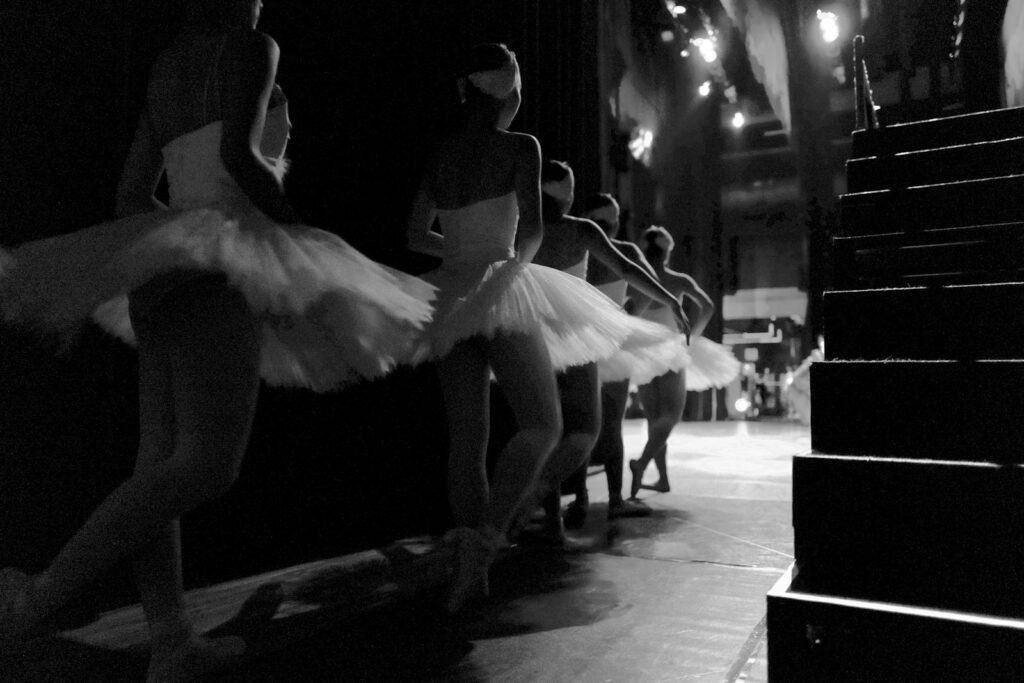
Enhanced Strength and Muscle Tone
In the enigmatic realm of ballet, the quest for heightened strength and muscle definition transcends mere physical beauty, delving into the art of refining the body to exude precision and vigor. As dancers, we are well aware of the necessity to fortify every muscle group in order to execute complex movements with ease and grace on stage.
Through rigorous ballet training, dancers cultivate an astonishing level of strength in their legs, core, arms, and back. The repetition of exercises such as pliés, tendus, and grand battements not only sculpts muscles but also fosters endurance and resilience. In the words of renowned ballerina Agnes de Mille: “The most authentic reflection of a culture is found in its dance and music. Bodies never deceive.” Indeed, the strength and muscle definition acquired through ballet not only elevates physical performance but also captures the very essence of artistic expression.
Better Posture and Alignment
The concept of good posture and alignment is akin to striking a captivating pose on a grand stage – it exudes grace, elegance, and confidence. Within the realm of ballet, there exists an emphasis on the significance of precise alignment extending from the very tips of your ts to the regal crown atop your head. In the words of the esteemed ballerina Margot Fonteyn, “The essence of a dancer’s beauty lies within her carriage.”
When one stands tall with shoulders squared and core activated, not only ds one appear more composed and elegant, but they also foster their body’s innate alignment and functionality. As practitioners of ballet, we diligently train our bodies to uphold this alignment throughout every plié and pirouette, which subsequently transcends into our daily experiences. Echoing the sentiments of renowned choreographer George Balanchine: “Ballet instills in you poise.” By honing in on our posture and alignment during ballet sessions, we enhance not only our physical presentation but also fortify our muscles while averting potential injuries.
Increased Endurance and Stamina
The seemingly effortless grace of dancing en pointe or executing pirouettes can deceive the untrained eye, for ballet is a demanding art that requires immense physical endurance and stamina. Each movement demands a sustained energy output, pushing the dancer’s cardiovascular system and muscular strength to their limits. As Misty Copeland, a legendary ballerina, once eloquently stated, “Ballet is a dance executed by the human soul.”
In the mysterious world of ballet, building endurance and stamina is a complex journey filled with rigorous training and unwavering practice. From the repetitive tendus at the barre to the daring leaps across the stage, dancers continuously strive to surpass their previous boundaries through sheer determination. The renowned choreographer George Balanchine aptly observed that “Ballet is important and significant – yes. But first of all, it is a pleasure.” Endurance and stamina not only elevate a dancer’s performance but also bring about an unparalleled sense of fulfillment and achievement, making every drop of sweat shed during practice worth its weight in gold.
Improved Balance and Coordination
The enigmatic allure of ballet lies in its mystical ability to heighten equilibrium and synchronicity, almost as if defying the laws of gravity. As a ballet instructor, I am constantly captivated by the metamorphosis of my students as they master the art of controlling their bodies with elegance and exactitude. It is akin to discovering your core balance and allowing it to navigate you through the intricate motions of dance.
Witnessing the seamless fluidity and gracefulness of a ballet dancer as they effortlessly perform a series of pirouettes or grand jetés is truly mesmerizing. In the words of renowned ballerina Agnes de Mille, “To dance is to be out of yourself… larger, more beautiful, more powerful.” Ballet not only enhances physical equilibrium and coordination but also fosters a sense of inner harmony and balance. It embodies a harmonious fusion of mind, body, and spirit that mirrors the fragile equilibrium we all strive for in our lives.
Mental Benefits of Ballet
One of the more elusive yet profoundly impactful advantages of ballet lies in its ability to enhance mental well-being. Participation in ballet not only cultivates physical strength and agility but also nurtures mental acuity and emotional fortitude. As dancers elegantly traverse the stage, their minds become fully engrossed in the cadence and synchronization of each intricate step. This intense concentration acts as a sort of meditation, enabling dancers to quiet their thoughts and discover inner serenity amidst the frenetic pace of the world surrounding them.
As acclaimed ballet dancer Mikhail Baryshnikov once remarked, “At its core, dance is all about expression and communication.” The psychological benefits of ballet extend beyond mere physicality; they penetrate deeply into the realms of emotional articulation and mental equilibrium. Through the medium of ballet, individuals are able to delve into their innermost sentiments and ideas, channeling them into powerful movements that narrate a tale without uttering a single word. This distinctive form of self-expression not only fosters mental lucidity but also facilitates individuals in establishing a profound connection with their emotions at an intrinsic level.
Reduced Stress and Anxiety
Ballet, with its enigmatic movements and emphasis on precision, serves as a mysterious refuge for those yearning to escape the overwhelming pressures of daily life. As dancers lose themselves in the rhythm and flow of their performance, their troubles dissipate into thin air, replaced by an aura of serenity and calmness. In the wise words of renowned ballerina Agnes de Mille, “The most authentic reflection of a culture is found in its dance and music. Bodies speak truths that words cannot.”
The strict discipline and unwavering focus demanded by ballet can function as a transcendental meditation practice, enabling dancers to silence their racing thoughts and flee from the pandemonium of the world beyond. Through movement, individuals are able to release pent-up emotions and stressors, undergoing a purifying catharsis that leaves them feeling weightless and harmonious. Echoing the sentiments of iconic choreographer George Balanchine: “Dance embodies audible melodies,” providing dancers with a sanctuary where anxiety has no place to dwell.
Enhanced Concentration and Focus
Ballet is a mesmerizing art form that gs beyond just fluid movements and poised stances; it serves as a formidable instrument to sharpen concentration and focus. As dancers, we delve into the minutiae – from the precise positioning of our feet to the perfect alignment of our arms. This unwavering attention to detail seeps into other facets of our existence, equipping us with the clarity and steadfastness needed to confront obstacles head-on.
The iconic ballerina, Margot Fonteyn, once remarked, “The one crucial lesson I’ve imbibed over time is distinguishing between taking one’s work seriously and taking oneself seriously.” Her words encapsulate the crux of ballet training succinctly – urging us to approach tasks with earnest commitment and laser-sharp focus while sidestepping distractions or self-doubt. Through the rigour and intense concentration demanded by ballet, we master the art of shutting out external clamour and directing all our energies towards achieving our aspirations.
Boosted Confidence and Self-Esteem
Confidence and self-esteem are akin to a flawless pirouette in the enchanting world of ballet – they are indispensable for an elegant performance. As a ballet instructor, I have personally observed the magical influence that this art form has on the dancers’ perception of their own worth. Witnessing their posture straighten, their movements gain assurance, and their smiles broaden with each rehearsal is truly gratifying.
In the immortal words of dancer extraordinaire Mikhail Baryshnikov, “To excel as a dancer, one must exude confidence in their abilities and have faith in themselves while on stage.” Ballet not only refines physical prowess but also nurtures a profound sense of self-assurance that transcends the confines of the dance studio. Each plié, tendu, and grand jeté represents progress towards bolstering confidence and self-esteem; instilling in dancers valuable lessons about resilience, persistence, and self-belief.
Improved Memory and Cognitive Function
In the realm of ballet, the essence lies not only in the physicality but also in the intricacies of the mind. The elaborate steps and sequences call for a profound level of cognitive prowess, pushing memory and concentration to their limits with each plié and pirouette. As dancers pursue perfection, they immerse themselves in a bewildering interplay of recollection and accuracy, refining their memory and cognitive capacities with every elegant motion.
The renowned choreographer George Balanchine famously remarked, “Dance is music made visible. That’s why dancers often make great musicians.” This intriguing link between movement and memory manifests itself as ballet dancers seamlessly merge corporeal grace with mental acumen. The rigorous discipline needed to commit intricate routines to memory not only hones cognitive abilities but also enhances problem-solving aptitude and spatial awareness forging a seamless equilibrium between body and mind on stage.
Greater Sense of Discipline and Commitment
In the enigmatic world of ballet, discipline and commitment reign supreme, guiding dancers on a tumultuous journey towards mastery. The eloquent musings of prima ballerina Alicia Markova echo through the hallowed halls of dance studios, proclaiming that true greatness lies not in mere technique, but in an unwavering passion that burns like a fierce inferno.
The relentless pursuit of perfection demands more than just physical prowess; it requires a steely resolve and unyielding resilience. As the illustrious Darcey Bussell once remarked, ballet is not just about perfecting movements it is about embracing one’s unique essence while striving for collective brilliance. This delicate balance between individuality and unity serves as a catalyst for boundless dedication and unwavering purpose, propelling dancers to soar beyond their limitations with every graceful turn, every elegant extension, and every breathtaking leap across the stage.


